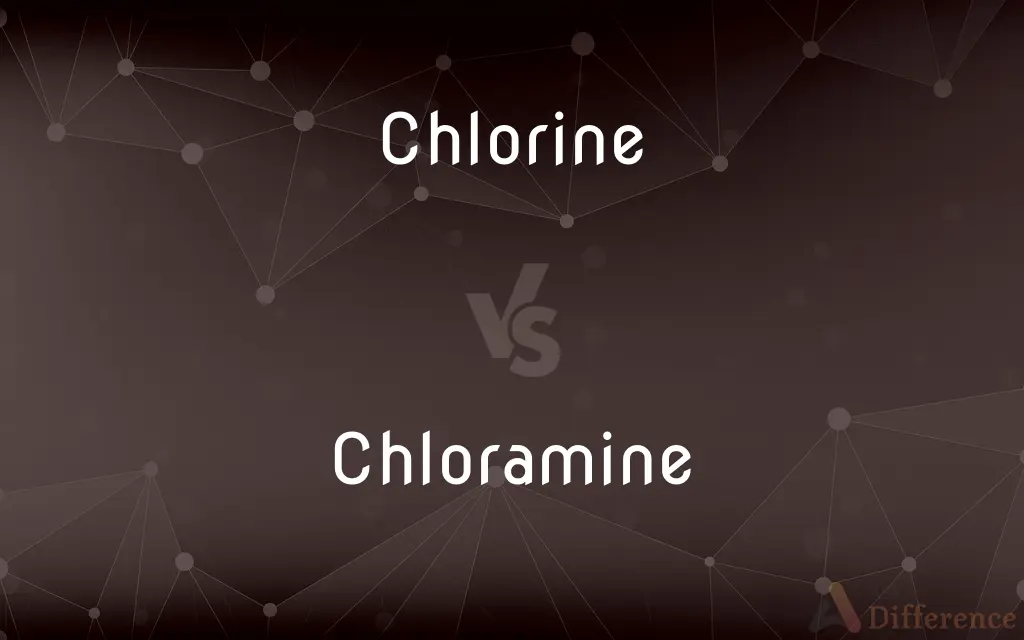Chlorine vs. Chloramine — What's the Difference?
By Urooj Arif & Maham Liaqat — Updated on May 2, 2024
Chlorine is a potent, fast-acting disinfectant used in water treatment, highly effective but dissipates quickly; chloramine is less reactive, providing longer-lasting water disinfection with fewer by-products.

Difference Between Chlorine and Chloramine
Table of Contents
ADVERTISEMENT
Key Differences
Chlorine is commonly used to disinfect water due to its strong oxidizing properties, effectively killing bacteria and viruses. Whereas, chloramine, a combination of chlorine and ammonia, is used as a secondary disinfectant because it is more stable and lasts longer in the water system.
Chlorine reacts quickly with organic matter in water, leading to the formation of disinfection by-products (DBPs) such as trihalomethanes (THMs) and haloacetic acids (HAAs), which can be harmful in high concentrations. On the other hand, chloramine forms fewer by-products, making it a safer choice in terms of long-term exposure risks.
The effectiveness of chlorine in killing pathogens is almost immediate, making it ideal for neutralizing rapidly spreading contaminants. In contrast, chloramine offers slower, more prolonged disinfection, which is beneficial for maintaining water quality across vast and complex distribution systems.
Chlorine's strong chemical reactivity can sometimes lead to a noticeable taste and smell in water, which some consumers find undesirable. Conversely, chloramine is much less likely to affect the sensory qualities of water, leading to fewer complaints about taste and odor.
Chlorine is typically easier and less expensive to use in water treatment processes compared to chloramine. However, the latter's extended-lasting disinfectant properties and lower health risks make it cost-effective for long-term water treatment strategies.
ADVERTISEMENT
Comparison Chart
Disinfection Speed
Fast-acting
Slower reaction
Stability in Water
Less stable, dissipates quickly
More stable, persists longer in water
By-product Formation
Higher levels of harmful by-products
Lower levels of by-products
Taste and Odor Impact
Can significantly impact water taste and odor
Minimal impact on taste and odor
Cost
Generally cheaper and easier to implement
More expensive, but cost-effective in the long term
Compare with Definitions
Chlorine
A chemical element used as a primary disinfectant in water treatment.
Chlorine gas is injected into water where it rapidly kills bacteria and viruses.
Chloramine
A compound of chlorine and ammonia used as a secondary disinfectant in water.
Chloramine is added to water supplies to ensure prolonged disinfection as water travels through pipes.
Chlorine
Known for its strong, pungent odor that is often noticeable in swimming pools.
The characteristic pool smell is often due to chlorine reacting with impurities in the water.
Chloramine
Its use requires careful balance and monitoring to maintain effectiveness without affecting water quality.
Too much chloramine can lead to ammonia buildup, which must be carefully controlled.
Chlorine
Can react with organic compounds in water to form potentially harmful by-products.
Chlorination of drinking water can lead to the formation of trihalomethanes (THMs).
Chloramine
Produces fewer disinfection by-products, reducing health risks associated with long-term exposure.
Use of chloramine decreases the levels of haloacetic acids and other harmful compounds in drinking water.
Chlorine
Used not only in water treatment but also in the production of paper products, dyes, and textiles.
Chlorine is used in bleaching processes during paper manufacturing.
Chloramine
Less aggressive and corrosive than chlorine, making it safer for long-term use in infrastructure.
Water treatment facilities that use chloramine report fewer corrosion problems in pipes and storage tanks.
Chlorine
Chlorine is a chemical element with the symbol Cl and atomic number 17. The second-lightest of the halogens, it appears between fluorine and bromine in the periodic table and its properties are mostly intermediate between them.
Chloramine
Maintains better residual disinfectant qualities in extensive piping systems.
Chloramine-treated water remains safe and potable even at the far reaches of a distribution system.
Chlorine
A highly irritating, greenish-yellow halogen element, existing as a diatomic gas, Cl2, and capable of combining with nearly all other elements, produced principally by electrolysis of sodium chloride and used widely to disinfect water, as a bleaching agent, and in the manufacture of many important compounds including chlorates, sodium hypochlorite, and chloroform. Atomic number 17; atomic weight 35.453; freezing point -100.5°C; boiling point -34.04°C; specific gravity 1.56 (-33.6°C); valence 1, 3, 5, 7. See Periodic Table.
Chloramine
An unstable colorless liquid, NH2Cl, used in making hydrazine and as a chlorine source for water treatment.
Chlorine
A toxic, green, gaseous chemical element (symbol Cl) with an atomic number of 17.
Chloramine
Any of several aromatic sulfonamide salts containing chlorine, used medicinally as antiseptics.
Chlorine
(countable) A single atom of this element.
Chloramine
(chemistry) any of a class of unstable compounds of nitrogen and chlorine R1R2NCl; also the parent compound NH2Cl, used to manufacture hydrazine, and as the antiseptic chloramine-T
Chlorine
One of the elementary substances, commonly isolated as a greenish yellow gas, two and one half times as heavy as air, of an intensely disagreeable suffocating odor, and exceedingly poisonous. It is abundant in nature, the most important compound being common salt (Sodium chloride). It is powerful oxidizing, bleaching, and disinfecting agent. Symbol Cl. Atomic weight, 35.4.
Chloramine
Any of several compounds containing chlorine and nitrogen; used as an antiseptic in wounds
Chlorine
A common nonmetallic element belonging to the halogens; best known as a heavy yellow irritating toxic gas; used to purify water and as a bleaching agent and disinfectant; occurs naturally only as a salt (as in sea water)
Chlorine
Requires careful handling due to its highly reactive and corrosive nature.
Chlorine gas must be stored in airtight containers to prevent leaks and exposure.
Common Curiosities
How are chlorine and chloramine added to water?
Chlorine can be added as a gas or in a dissolved form, while chloramine is formed by mixing chlorine with ammonia under controlled conditions.
What is the primary use of chlorine and chloramine in water treatment?
Both chlorine and chloramine are used to disinfect water, but chlorine is used primarily for rapid disinfection, while chloramine provides longer-lasting water quality control.
Why is chloramine preferred over chlorine in some water systems?
Chloramine is preferred in some systems because it provides longer-lasting disinfection with fewer by-products, which reduces health risks.
Can chlorine and chloramine affect the taste and smell of water?
Yes, chlorine can cause a strong taste and smell, whereas chloramine has a much lesser impact on the sensory qualities of water.
What are the health risks associated with chlorine and chloramine?
Chlorine can produce harmful by-products like THMs and HAAs, which are associated with cancer risks; chloramine produces fewer of these compounds but can still pose risks if not properly managed.
Which is more cost-effective for municipal water treatment?
Chlorine is cheaper and easier to use, but the long-term benefits of chloramine can outweigh its higher initial cost due to reduced by-product management and infrastructure corrosion.
How do chlorine and chloramine affect aquatic life?
Both chemicals can be toxic to aquatic life; measures must be taken to ensure that water containing these disinfectants does not enter natural water bodies without adequate treatment.
Is bottled water treated with chlorine or chloramine?
Bottled water is typically treated using processes that do not leave residual disinfectants, such as distillation or reverse osmosis.
How do environmental regulations impact the use of chlorine and chloramine?
Environmental regulations mandate limits on disinfection by-products, influencing how and when each chemical is used in public water systems.
How do the disinfectant properties of chlorine and chloramine compare?
Chlorine is more potent and faster acting than chloramine, but chloramine offers more consistent and long-lasting disinfection.
What precautions are necessary when handling chlorine and chloramine?
Both chemicals require careful handling to avoid exposure and inhalation risks; protective gear and proper ventilation are essential.
Are there alternatives to using chlorine and chloramine in water disinfection?
Alternatives include UV light treatment and ozone treatment, which do not introduce chemicals into the water but may be more expensive and technologically demanding.
Can home water filters remove chlorine and chloramine?
Yes, activated carbon filters and reverse osmosis systems are effective at removing both chlorine and chloramine from tap water.
What is the impact of chlorine and chloramine on plumbing and appliances?
Chlorine can be more corrosive to plumbing and appliances, whereas chloramine is less so but can still cause issues like pitting and degradation over time.
How should water be treated if both immediate disinfection and long-term stability are needed?
A combination approach can be used, starting with chlorine for immediate disinfection followed by chloramine to maintain longer-lasting water quality throughout the distribution system.
Share Your Discovery

Previous Comparison
Kale vs. Money
Next Comparison
Snapdragon vs. GladiolusAuthor Spotlight
Written by
Urooj ArifUrooj is a skilled content writer at Ask Difference, known for her exceptional ability to simplify complex topics into engaging and informative content. With a passion for research and a flair for clear, concise writing, she consistently delivers articles that resonate with our diverse audience.
Co-written by
Maham Liaqat















































